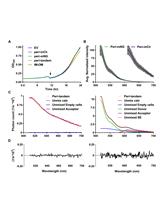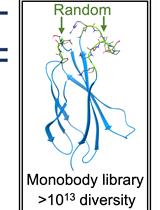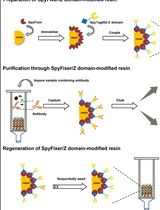- EN - English
- CN - 中文
Analysis of Direct Interaction between Viral DNA-binding Proteins by Protein Pull-down Co-immunoprecipitation Assay
蛋白质pull-down免疫共沉淀实验分析病毒DNA结合蛋白质之间的直接相互作用
发布: 2018年01月05日第8卷第1期 DOI: 10.21769/BioProtoc.2678 浏览次数: 12137
评审: Dennis NürnbergSeda EkiciAnonymous reviewer(s)

相关实验方案

采用Förster共振能量转移法检测大肠埃希杆菌细胞质和周质中蛋白质的相互作用
Nils Y. Meiresonne [...] Tanneke den Blaauwen
2018年01月20日 14274 阅读
Abstract
This protocol analyzes the direct interaction between two DNA-binding proteins by pull-down co-immunoprecipitation. One of the proteins is overexpressed in E. coli as HA-tagged recombinant protein and cell-free extracts are immunoprecipitated in HA-affinity resin. Cell extracts are treated with nuclease to degrade DNA and RNA, which rules out nucleic acid-mediated indirect interaction. Then, a second immunoprecipitation step is performed using the purified putative partner protein. Co-immunoprecipitated proteins can be detected either by Coomassie Blue staining and/or Western blotting (WB) if a specific antibody is available. Moreover, many DNA/RNA binding proteins are highly electropositive, which can hinder WB under standard conditions, as has been shown in histones and histone-like proteins. In this case, we show that the high isoelectric point of the putative partner results in a poor transfer. Tips to troubleshot WB transfer of highly electropositive DNA-binding proteins are provided.
Keywords: Co-immunoprecipitation (免疫共沉淀)Background
Co-immunoprecipitation is a commonly used method to analyze protein-protein interactions (PPIs). Many co-immunoprecipitation protocols use bacteria-expressed proteins. However, the use of cell extracts does not preclude indirect interactions mediated by third proteins or, in the case of DNA/RNA binding proteins, nucleic acids.
Terminal protein of tectivirus Bam35 (B35TP) contains the conserved Tyrosine 194 that provides the OH group to anchor the first 5’-dTMP of the viral genome during protein-primed DNA replication. Moreover, B35TP has strong DNA-binding capacity and, like many DNA-binding proteins, it has a very high isoelectric point (about 10.6), which affect its stability and function in vitro (Berjón-Otero et al., 2016).
The aim of this protocol was to confirm the direct interaction between B35TP and the viral protein P1, a putative transcription factor, originally detected in a genome-wide yeast two hybrid screening (Berjón-Otero et al., 2017). We avoided indirect interactions mediated by nucleic acids by using benzonase-treated cell extracts to immunoprecipitate the bait protein (P1) and the purified recombinant protein as the interacting partner (B35TP).
Materials and Reagents
- Bacterial cell-free extract preparation
- 1.5 ml microcentrifuge tubes (SARSTEDT, catalog number: 72.690 )
- E. coli BL21(DE3) (New England Biolabs, catalog number: C2527I )
- Glycerol (Sigma-Aldrich, catalog number: G5516 )
- LB Broth (Sigma-Aldrich, catalog number: L3522 )
- Ampicillin (Sigma-Aldrich, catalog number: A9518 )
- Glucose (Sigma-Aldrich, catalog number: G5516 )
- TYM-5052 autoinduction medium (Studier, 2005) (ForMedium, catalog number: AIMLB0205 )
- cOmpleteTM ULTRA Tablets, EDTA-free, glass vials Protease Inhibitor Cocktail (Sigma-Aldrich, Roche Diagnostics, catalog number: 05892953001 )
- Lysozyme from chicken egg white (Sigma-Aldrich, catalog number: L6876 )
- Benzonase® Nuclease (Sigma-Aldrich, catalog number: E1014 )
- Magnesium chloride hexahydrate (MgCl2·6H2O) (Sigma-Aldrich, catalog number: M2670 )
- Ethylenediaminetetraacetic acid (EDTA) (Sigma-Aldrich, catalog number: E6758 )
- Sodium chloride (NaCl) (Sigma-Aldrich, catalog number: S7653 )
- Potassium chloride (KCl) (Sigma-Aldrich, catalog number: P9333 )
- Sodium phosphate dibasic (Na2HPO4) (Sigma-Aldrich, catalog number: S7907 )
- Potassium phosphate monobasic (KH2PO4) (Sigma-Aldrich, catalog number: 1551139 )
- Hydrochloric acid (HCl) (Sigma-Aldrich, catalog number: 435570 )
Note: This product has been discontinued. - Phosphate buffered saline pH 8 (PBS pH 8) (see Recipes)
- 1.5 ml microcentrifuge tubes (SARSTEDT, catalog number: 72.690 )
- Co-immunoprecipitation
- 1.5 ml microcentrifuge tubes (SARSTEDT, catalog number: 72.690 )
- Pierce® Anti-HA agarose (Thermo Fisher Scientific, Thermo ScientificTM, catalog number: 26181 )
- Bovine serum albumin (BSA) (Sigma-Aldrich, catalog number: A4503 )
- Glycine (Sigma-Aldrich, catalog number: G8898 )
- Sodium chloride (NaCl) (Sigma-Aldrich, catalog number: S7653 )
- Potassium chloride (KCl) (Sigma-Aldrich, catalog number: P9333 )
- Sodium phosphate dibasic (Na2HPO4) (Sigma-Aldrich, catalog number: S7907 )
- Potassium phosphate monobasic (KH2PO4) (Sigma-Aldrich, catalog number: 1551139 )
- Tween® 20 (Sigma-Aldrich, catalog number: P1379 )
- Sodium dodecyl sulfate (SDS) (AppliChem, catalog number: A2572 )
- Trizma base (Sigma-Aldrich, catalog number: T1503 )
- 2-Mercaptoethanol (Sigma-Aldrich, catalog number: M6250 )
- Glycerol (Sigma-Aldrich, catalog number: G5516 )
- Bromophenol blue (Sigma-Aldrich, catalog number: B0126 )
- Hydrochloric acid (HCl) (Sigma-Aldrich, catalog number: 435570 )
- Phosphate buffered saline pH 8 (PBS pH 8) (see Recipes)
- Phosphate buffered saline pH 8 with Tween (PBS-T pH 8) (see Recipes)
- 4x Laemmli SDS-PAGE sample buffer (see Recipes)
- 1.5 ml microcentrifuge tubes (SARSTEDT, catalog number: 72.690 )
- Western-blot
- Immobilon-P Membrane, PVDF, 0.45 µm, 26.5 x 3.75 m roll (Merck, catalog number: IPVH00010 )
- Grade 3MM Chr Blotting Paper, sheet, 46 x 57 cm (GE Healthcare, catalog number: 3030-917 )
- X-ray film (VWR, catalog number: 11299-022 )
Manufacturer: Associated Metals, catalog number: UPM0810 . - SeeBlueTM Plus2 Pre-stained Protein Standard (Thermo Fischer Scientific, InvitrogenTM, catalog number: LC5925 )
- Coomassie Blue R250 (Sigma-Aldrich, catalog number: 27816 )
- Methanol (Sigma-Aldrich, catalog number: 32213 )
- Antibodies (e.g., anti-TP serum raised in rabbits, goat anti-rabbit horseradish peroxidase-conjugate antibody [GE Healthcare, catalog number: RPN4301 ])
- ECLTM Blotting Reagents (GE Healthcare, catalog number: RPN2109 )
- Trizma® base (Sigma-Aldrich, catalog number: T1503 )
- Glycine for molecular biology (AppliChem, catalog number: A1067 )
- Sodium dodecyl sulfate (SDS) (AppliChem, catalog number: A2572 )
- Low fat milk powder (e.g., Nestle Sveltesse)
- Acrylamide/Bis Solution, 37.5:1 (40% w/v), 2.6% C (SERVA Electrophoresis, catalog number: 10681.01 )
- Ammonium peroxodisulfate for analysis EMSURE® ACS, Reag. Ph Eur. (APS) (Merck, catalog number: 1012010500 )
- N,N,N’,N’-Tetramethyl ethylenediamine (TEMED) GR for analysis (Merck Millipore, catalog number: 1107320100 )
- Phosphate buffered saline pH 7.5 (PBS) (see Recipes)
- Phosphate buffered saline pH 7.5 with Tween (PBS-T) (see Recipes)
- 4x Laemmli SDS-PAGE sample buffer (see Recipes)
- Western electrophoresis buffer (see Recipes)
- Blocking solution (see Recipes)
- SDS-PAGE running buffer (see Recipes)
- Polyacrylamide gel with 5% stacking gel and 15% running gel (see Recipes)
- Transfer buffers (see Recipes)
- Western transfer buffer
- Standard transfer buffer
- Modified transfer buffer
- Western transfer buffer
- Immobilon-P Membrane, PVDF, 0.45 µm, 26.5 x 3.75 m roll (Merck, catalog number: IPVH00010 )
Equipment
- 50 ml flasks (v.g. VWR, catalog number: 214-1130 )
- Micropipettes (Gilson, model: PIPETMAN, catalog numbers: F144801 , F144600 , F144601 and F144802 )
- Incubator shaker for bacterial cultures
- Refrigerated centrifuge (Hettich, model: MIKRO 22R )
- Thermomixer compact (Eppendorf, catalog number 5386000010 )
- Gel electrophoresis chamber (Mini-Protean®, Bio-Rad Laboratories, catalog number: 1658004 )
- Tank blot device (Mini Trans-Blot® Electrophoretic Transfer cell, Bio-Rad Laboratories, catalog number: 1703930 )
- Rotating wheel
- Developer (Kodak, model: X-OMAT 2000 processor ) or WB documentation system
- Autoradiography Cassette (Amersham Hypercassette)
- Sonicator (Sartorius, model: LABSONIC® M )
Procedure
文章信息
版权信息
© 2018 The Authors; exclusive licensee Bio-protocol LLC.
如何引用
Lechuga, A., Berjón-Otero, M., Salas, M. and Redrejo-Rodríguez, M. (2018). Analysis of Direct Interaction between Viral DNA-binding Proteins by Protein Pull-down Co-immunoprecipitation Assay. Bio-protocol 8(1): e2678. DOI: 10.21769/BioProtoc.2678.
分类
微生物学 > 微生物生物化学 > 蛋白质 > 免疫检测
生物化学 > 蛋白质 > 相互作用 > 蛋白质-蛋白质相互作用
生物化学 > 蛋白质 > 免疫检测 > 免疫沉淀(IP)
您对这篇实验方法有问题吗?
在此处发布您的问题,我们将邀请本文作者来回答。同时,我们会将您的问题发布到Bio-protocol Exchange,以便寻求社区成员的帮助。
提问指南
+ 问题描述
写下详细的问题描述,包括所有有助于他人回答您问题的信息(例如实验过程、条件和相关图像等)。
Share
Bluesky
X
Copy link











